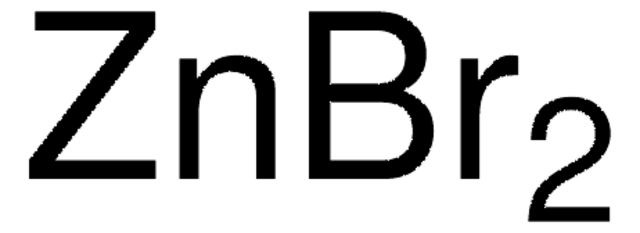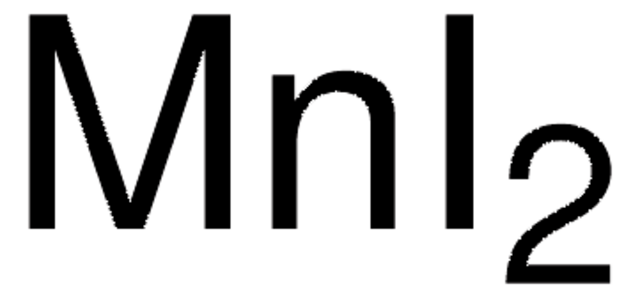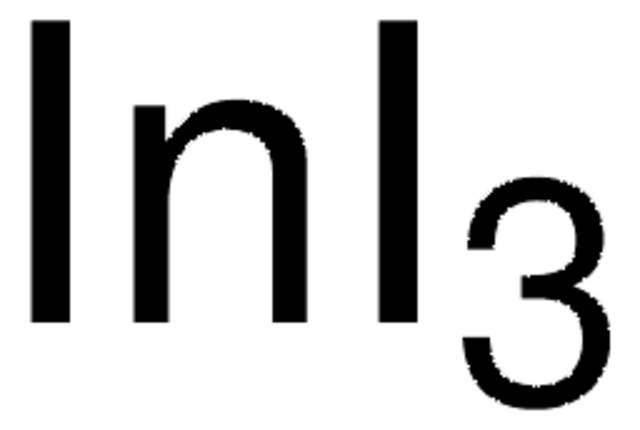모든 사진(2)
About This Item
Linear Formula:
ZnI2
CAS Number:
Molecular Weight:
319.20
EC Number:
MDL number:
UNSPSC 코드:
12352302
PubChem Substance ID:
NACRES:
NA.23
추천 제품
Grade
for analytical purposes
Quality Level
분석
≥99.99% trace metals basis
양식
crystalline
반응 적합성
reagent type: catalyst
core: zinc
불순물
≤100.0 ppm Trace Metal Analysis
mp
445 °C (lit.)
density
4.74 g/mL at 25 °C (lit.)
SMILES string
I[Zn]I
InChI
1S/2HI.Zn/h2*1H;/q;;+2/p-2
InChI key
UAYWVJHJZHQCIE-UHFFFAOYSA-L
유사한 제품을 찾으십니까? 방문 제품 비교 안내
일반 설명
Zinc iodide is a faint yellow solid that absorbs water readily. It is synthesized using metallic zinc with an aqueous iodine solution. It is used as a Lewis acid for organic conversion.
애플리케이션
Zinc iodide can be used as:
- An electrolyte in Zinc-iodine redox flow batteries.
- An additive to prepare air-stable cationic lead perovskite films. The addition of ZnI2 enhances the film stability and photoluminescence without affecting the bandgap.
- As a precursor to prepare efficient, eco-friendly, and high color purity inkjet-printed blue InP/ZnS/ZnS quantum dot light-emitting diodes.
- A catalyst in promoting various chemical transformations, for example, in the direct synthesis of 2,3-Dihydroisoxazoles via a [3+2] cycloaddition reaction of the nitrones and terminal alkynes.
- An activator/initiator in living cationic polymerization reactions.
신호어
Warning
유해 및 위험 성명서
Hazard Classifications
Aquatic Acute 1 - Aquatic Chronic 1 - Eye Irrit. 2 - Skin Irrit. 2 - STOT RE 2 Oral
표적 기관
Thyroid
Storage Class Code
13 - Non Combustible Solids
WGK
WGK 3
Flash Point (°F)
Not applicable
Flash Point (°C)
Not applicable
개인 보호 장비
Eyeshields, Faceshields, Gloves, type P3 (EN 143) respirator cartridges
이미 열람한 고객
N Mayer-Gostan et al.
Cell and tissue research, 289(1), 53-61 (1997-07-01)
The saccular membranes of trout (Oncorhynchus mykiss) and turbot (Scophthalmus maximus) were examined to characterize specialized epithelial cells that might be responsible for ion exchange. The approach for localizing cell types was new for this tissue, as observations were made
Lei Han et al.
Inorganic chemistry, 46(5), 1511-1513 (2007-02-08)
Hydrothermal reaction of 4,4-trimethylenedipyridine (tmdp) with ZnI2 under 175 degrees C yields a novel compound, {[Zn2I4(tmdp)2]n.[Zn2I4(tmdp)2]n}, which has a chiral infinite double-stranded helical structure consisting of two single-stranded helices of the same handedness.
Jie Ma et al.
Chemistry, an Asian journal, 5(10), 2214-2220 (2010-08-03)
Transition-metal-activated alkynes or allenes can accept nucleophilic attack and undergo direct addition of the nucleophiles to the unsaturated bonds or trigger subsequent rearrangement reactions. This chemistry has witnessed increasing development in recent years. In this report, we have focused on
C Slomianny et al.
The Journal of protozoology, 37(6), 465-470 (1990-11-01)
We have used ultrastructural techniques in different malarial species to demonstrate a lysosomal system. First, we have tried to localize acid phosphatase, a typical lysosomal label. Its activity was localized in the endoplasmic reticulum and in endocytic vesicles, and in
M Benchimol et al.
Experimental parasitology, 59(1), 51-58 (1985-02-01)
The zinc iodide-osmium tetroxide technique was used to analyze the distribution of the endoplasmic reticulum-Golgi complex system of Tritrichomonas foetus. Interconnections between the cisternae of the endoplasmic reticulum as well as between cisternae of the Golgi complex were observed. The
문서
Colloidal quantum dots (CQDs) are semiconducting crystals of only a few nanometers (ca. 2–12 nm) coated with ligand/surfactant molecules to help prevent agglomeration.
자사의 과학자팀은 생명 과학, 재료 과학, 화학 합성, 크로마토그래피, 분석 및 기타 많은 영역을 포함한 모든 과학 분야에 경험이 있습니다..
고객지원팀으로 연락바랍니다.











